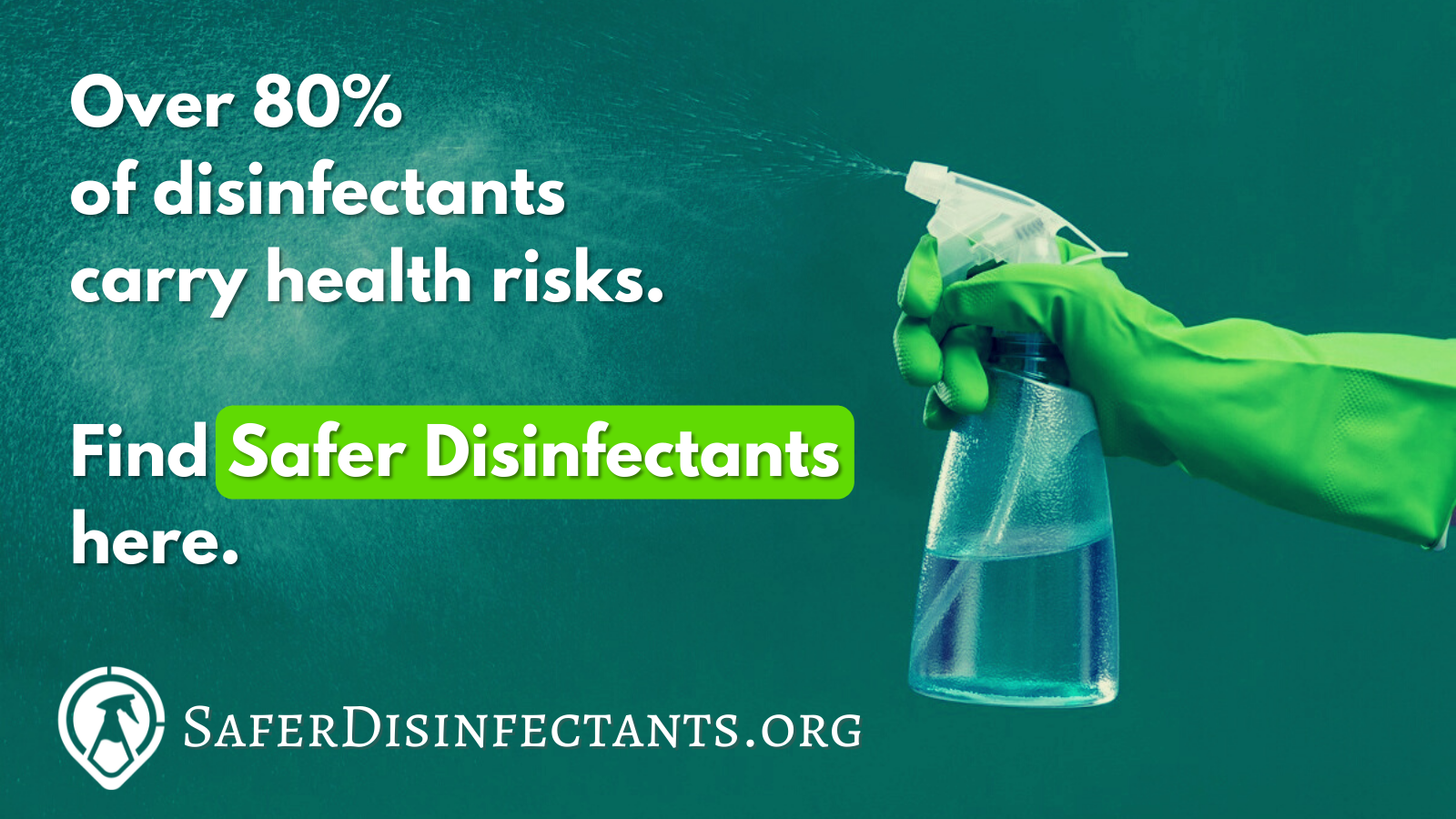
09 Sep First-in-the-Nation Website Identifies Safer Disinfectant Options
Online tool helps schools, the healthcare industry, and consumers sanitize and protect from COVID-19 variants without exposure to dangerous chemicals
Although the use of disinfectants has increased in recent years due to the COVID-19 pandemic, there has been limited public knowledge about the potential serious health consequences associated with some of these disinfectants, including the exacerbation of COVID-19 variant symptoms. Maryland Pesticide Education Network’s (MPEN) new website, www.SaferDisinfectants.org, helps schools, the healthcare industry, and consumers understand the health risks linked to certain pesticide-registered disinfecting products and find safer products for use against the novel coronavirus.
“Not all disinfectants are created equal,” Bonnie Raindrop, MPEN project director, said. “With this new site, we’re hoping to provide a resource to keep communities safe and healthy by providing information about what disinfectants can protect against COVID-19 without causing dangerous side effects.”
The Environmental Protection Agency (EPA) has issued a list – known as “List N” – of disinfectants that kill SARS-CoV-2 virus (COVID-19) and its variants. The EPA evaluates disinfectants for effectiveness against SARS-CoV-2; however, the EPA list does not consider the increased health risks that many pesticide-registered disinfectants cause, including weakened immune systems and induced and worsened respiratory illnesses.
SaferDisinfectants.org, a first-of-its-kind website, provides users with an easy way to differentiate these hazardous disinfectants from safer alternatives. The website identifies over 100 safer, effective disinfectant products EPA approves for protection against COVID-19 that contain safer active ingredients, such as isopropyl and ethyl alcohol, hydrogen peroxide, thymol, L-lactic acid, citric acid, and sodium carbonate. The website allows users to customize their views to identify products by the surface type they wish to disinfect (e.g., porous or hard surface), the type of use site (institutional, healthcare, or residential), as well as browse products, search by product name, and filter the list by other criteria.
“This website gives people peace of mind when buying disinfectants, without having to sift through hundreds of research studies on their own,” said Margie Roswell, website developer, Roswell Infographic.
With the rise of BA.5 omicron subvariant, some schools are planning on implementing disinfectant space spraying – also known as fogging – in an attempt to keep students healthy.
“Fogging is a huge concern with some of these disinfectants,” said Dr. Ana Rule, Johns Hopkins School of Public Health. “Disinfectant particles are going to stay in the air, which means they might be inhaled and irritate the respiratory system if facilities don’t allow enough time to pass before people occupy the space. People think they are cleaning the air, but they are not. Fogging has been associated with an increased risk of asthma and respiratory symptoms, yet these pesticide-registered disinfectants are being used indiscriminately in schools, planes, churches, and hospitals. Space spraying creates a false sense of security and potentially an increased risk.”
Over 80% of the pesticide-registered disinfectants on List N contain chemicals that are associated with increased health risks. These chemicals include numerous quaternary ammonium compounds (QACs) and chlorine-based products, which can injure respiratory systems and the human immune system, reducing people’s overall resistance to disease and increasing the risk of viral and bacterial infections.
Exposure to QACs can cause asthma, worsen respiratory illnesses, and prompt increased antibiotic resistance. They persist on surfaces for weeks and have also been associated with reproductive disorders. Exposure to QACs and chlorine-based disinfectants can cause eye and skin injuries, as well.
“QACs and chlorine bleach products are potent irritants, especially to the respiratory system,” said Dr. Michael Ichniowski, pediatrician, Maryland Chapter of America Academy of Pediatrics. “Exposure can trigger acute symptoms in asthmatics, but it is also capable of causing asthma in people previously without it, especially children. Children are at particular risk, due to their more rapid rate of breathing and because their lungs are still growing and developing.”
SaferDisinfectants.org was designed to update daily with a live feed from EPA’s List N, so information is constantly current. The website automatically distinguishes products’ hazard rating as “safer” or “increased risk” based upon the product’s active ingredients. The website also includes FAQ, blog posts, and an email list sign-up.
The website reiterates users should always follow manufacturer’s directions whenever using disinfectants and should never mix disinfectants and/or cleaning products. Mixing bleach and other disinfectants can be extremely dangerous. Additional precautions should always be taken when using disinfecting products around children, who are at greater risk from these products.
Visit www.SaferDisinfectants.org. More information, including a printable Safer Disinfectants Buying Guide, can be found here.
SaferDisinfectants.org was developed by Margie Roswell of Roswell Infographics for The Maryland Pesticide Education Network, which works to protect the public and the natural systems we depend on from the toxic impacts of pesticides, www.mdpestnet.org.